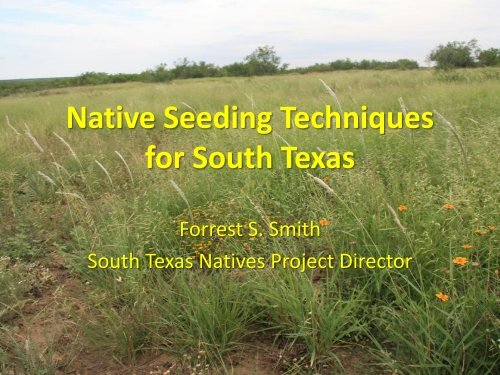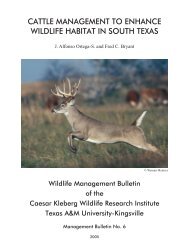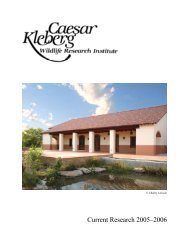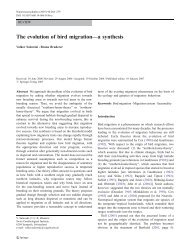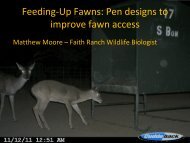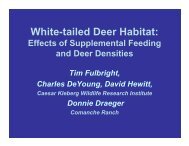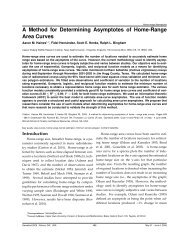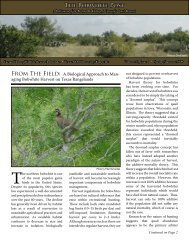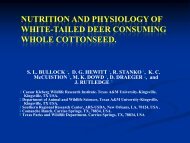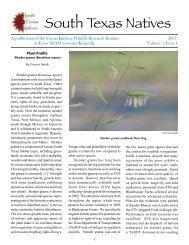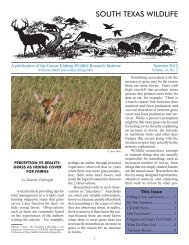Native Seeding Techniques for South Texas - Caesar Kleberg ...
Native Seeding Techniques for South Texas - Caesar Kleberg ...
Native Seeding Techniques for South Texas - Caesar Kleberg ...
Create successful ePaper yourself
Turn your PDF publications into a flip-book with our unique Google optimized e-Paper software.
<strong>Native</strong> <strong>Seeding</strong> <strong>Techniques</strong><strong>for</strong> <strong>South</strong> <strong>Texas</strong>Forrest S. Smith<strong>South</strong> <strong>Texas</strong> <strong>Native</strong>s Project Director
When to plant native seed?Situation<strong>Native</strong> seedbank absentSlow vegetation recovery followingother treatmentsTo prevent soil erosionLimit weedy or invasive speciesestablishmentImprove plant diversity, structure, orcompositionExamples•Retired cropland•Engineered soils•Oil and gas production pads•Severely overgrazed rangelands•After severe wildfire•Following brush management•Pond and tank embankments•Watershed work•Highway or energy right of ways•Brush control•Pipeline, power line, or highway right ofway installation•Exotic grass pasture diversification•Degraded rangeland improvement•Wildlife habitat improvement
Critical concerns <strong>for</strong> seeding projects:1. Land use history2. Site attributes3. Site preparation and resulting seedbed4. Planting method, date, and seed mixture5. Post planting precipitation6. Post planting management
What are our conclusions based on?30 plantings we have conducted since 2004• All used <strong>South</strong> <strong>Texas</strong> origin seed• Sampled late spring & autumn each year• Overall success rate 70%• Successful plantings defined as:– >0.5 seeded plants/ft2 @ 1-2 yrs. after sowing– >30% seeded plant cover by 1 yr after sowing
Land use history: How successful areseeding projects on common sites?• Retired cropland (50%)• Degraded native sites (83%)• Exotic grass diversification (75%)
Retired croplands• Success rates are modest (
Degraded native rangelands• Success rates very high (83%)• Rapid establishment of plants from seed• Minimal seedbed preparation + no-till drillinghas been very effective
Exotic grass pastures• Good per<strong>for</strong>mance in the context of typicalmeasures of success (75%)• Exotic grasses are not excluded or eliminated,but native plant establishment is good• By 2 years post-planting, management tofavor natives will be necessary in most cases
Site preparation methods• Double disking only was the site preparationmethod <strong>for</strong> most failed plantings• Site preparation methods that resulted in thebest establishment:– Summer fire + double disking– Deep plowing + multiple disking– Herbicide (glyphosate) only (no till drill)– Sorghum cover crop + disking
Seed mixture recommendations• High-diversity mixes were more successfulwhen paired with low-diversity mixes• Inclusion of early successional plants isimportant <strong>for</strong> success in
Seed mixture recommendations• Early successional grasses and <strong>for</strong>bs (50% of mix)– Welder Germplasm shortspike windmillgrass– Dilley Germplasm slender grama• Mid successional grasses (25% of mix)– Catarina Blend Bristlegrass– La Salle Germplasm Arizona cottontop• Late successional species rarely establish withoutother species present (25% of mix)– Kinney Germplasm false rhodesgrass– Falfurrias Germplasm big sacaton
Seed mixture selection tool on<strong>South</strong> <strong>Texas</strong> <strong>Native</strong>s Website under<strong>Seeding</strong> Recommendations
Planting methods• Most plantings done with a Truax® Flex II drill• Drilling: 76% successful• No-till drilling: 100% successful• Broadcast seeding is not as effective as drillseeding in our assessment
Seedbed conditions• 100% success in firm, aggregated seedbeds• Failed seedings were in:– Cloddy, uneven seedbeds– Loose, fluffy seedbeds
Sowing date• Success by month of sowing:– February: 0%– March: 50%– April: 66%– July: 0%– August: 100%– September: 88%– October: 80%– November: 0%
Precipitation (rainfall in 1 st year aftersowing)• No surprise-most failed plantings had poorrainfall after sowing• However: 5 of 8 plantings made in late 2008were very successful• Average rainfall results in good establishmentof native seed
Example 1: Duval County• Degraded nativerangeland• Alet sandy clay loam soil• 3x Glyphosate herbicide• No-till drilled• Firm seedbed• Planted August 2008• 11 species native mix• Fair precipitation in fall2008 (
March 2009 September 2009November 2009 June 2010
Duval County planting 2008-2011:% cover by sampling date90.00%(Prescribed fire)80.00%70.00%60.00%50.00%40.00%30.00%nativenon-nativebarevolenteer20.00%10.00%0.00%
Example 2: Webb CountyPlanting 1• Buffelgrass pasture• Brystal fine sandy loam• Glyphosate + double disk• Drill seeded• Rough, cloddy seedbed• Planted August 2008• 11 species native mix• Good rainfall-fall 2008(13.15”), poor spring-fall2009 (none)Planting 2• Buffelgrass pasture• Duval fine sandy loam• Glyphosate + double disk• Drill seeded• Rough, cloddy seedbed• Planted August 2008• 11 species native mix• Good rainfall-fall 2008(13.05”), poor spring-fall2009 (none)
10/1/20081/1/20094/1/20097/1/200910/1/20091/1/20104/1/20107/1/201010/1/20101/1/20114/1/20117/1/201110/1/20081/1/20094/1/20097/1/200910/1/20091/1/20104/1/20107/1/201010/1/20101/1/20114/1/2011Example 2: Webb County plantings% cover by sampling date 2008-2011Brystal fine sandy loam-% cover by sampling date0.7Duval fine sandy loam-% cover by sampling date0.70.60.60.50.50.40.4nativenative0.3non-native0.3non-native0.2barevolenteer0.2barevolenteer0.10.100
Example 2: Webb County (Brystal soilleft, Duval soil right)August 2008 August 2008July 2010 July 2010
Example 3: Maverick County• Buffelgrass dominated/recently root plowed• August prescribed fire(no soil moisture) +double disking• Rough, cloddy seedbed• Drill planted• Planted August 2009• 11 species native mix• Good rainfall Sept.2009-Sept. 2010
Example 3: Maverick CountyAugust 2009 November 2009June 2010 November 2010
10/1/200811/1/200812/1/20081/1/20092/1/20093/1/20094/1/20095/1/20096/1/20097/1/20098/1/20099/1/200910/1/200911/1/200912/1/20091/1/20102/1/20103/1/20104/1/20105/1/20106/1/20107/1/20108/1/20109/1/201010/1/201011/1/201012/1/20101/1/20112/1/20113/1/20114/1/20115/1/20116/1/20117/1/2011Example 3 Maverick County:% cover by sampling date 2009-20110.90.80.70.60.50.40.3nativenon-nativebarevolenteer0.20.10
Example 4: <strong>Kleberg</strong> County• Active cropland• Final crop (sorghum)harvested July 2008• Clean, firm seedbed• Lightly disked• Drill planted September2008• 11 species native mix• 6” rainfall by November2008, none untilfollowing September
Example 4: <strong>Kleberg</strong> CountyAugust 2008 November 2009March 2010 June 2010
Example 3 <strong>Kleberg</strong> County:% cover by sampling date 2008-2011100.00%90.00%80.00%70.00%60.00%50.00%40.00%30.00%seeded nativebaregroundnon-nativevolunteer20.00%10.00%0.00%
% changeThe big questions: Exotics vs. <strong>Native</strong>sThe key is to start without exotics!0.350.3Change in cover between sampling periods after seeding2008-2011P=0.440A0.250.20.150.10.05AP=0.530AAP=0.073AAP=0.654AAP=0.302AAP=0.296AAnativenon-native01 2 3 4 5 6Sampling period after planting
The big questions: <strong>Seeding</strong> Method?research in progress• Expensive• Effective• Time consuming• Equipment hard toobtain in <strong>South</strong> <strong>Texas</strong>• Low cost• Practical <strong>for</strong> largelandscapes• Traditionally modestsuccess rates (withother seed sources inother regions)
The big questions: What to plant?Plant the right species <strong>for</strong> your site• Use the NRCS EcologicalSite Descriptions as astarting point <strong>for</strong>natural systems• Sample relict sites onthe same soils• Use seed mixes with theability to provide >50%cover in
The big questions: Best site prep?Conduct treatments over more than 1• Control of the seedbank ofunwanted plants is veryimportant• Fire, herbicides, and soildisturbance all have theirplace, in combination• Deep tillage, followed byrepeated, shallow cultivationover long, wet intervals is themost successful control ofexotics• Repeated, low rateapplications of glyphosate arealso effective, especially if notilldrilling is a planting optiongrowing season.
Recommendations:1. Use multiple seedbed preparation treatments tocreate an ideal seedbed and control the seed banksof undesirable plants be<strong>for</strong>e planting2. Plant in late August-September to maximize thechance of adequate precipitation <strong>for</strong> establishment3. Maximize diversity in your seed mix-but includelarge percentages of early successional species4. There are many confounding factors-get as many asyou can right and the chances of success are good!


